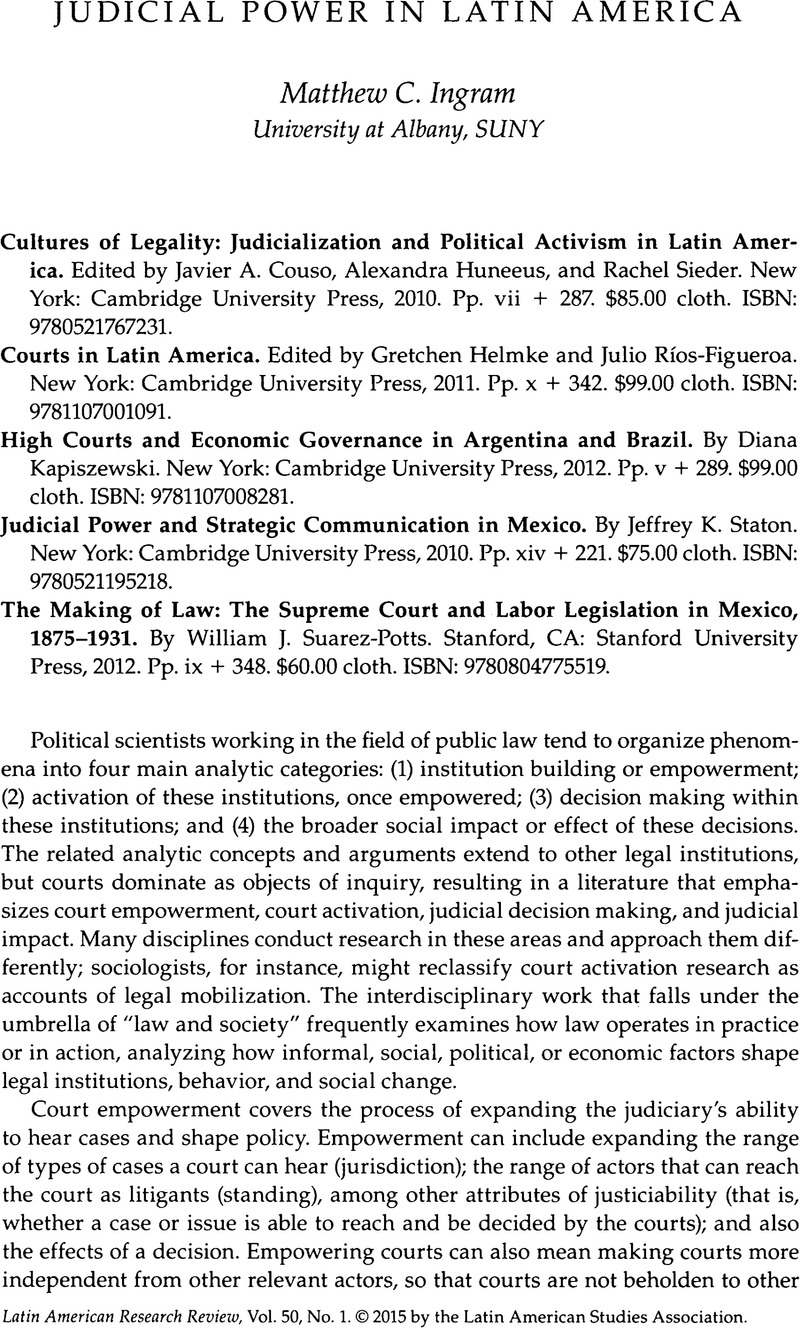Published online by Cambridge University Press: 05 September 2022

1. Tom Ginsburg, Judicial Review in New Democracies: Constitutional Courts in Asian Cases (New York: Cambridge University Press, 2003).
2. Charles Epp, The Rights Revolution: Lawyers, Activists, and Supreme Courts in Comparative Perspective (Chicago: University of Chicago Press, 1998).
3. Jeffrey A. Segal and Harold J. Spaeth, The Supreme Court and the Attitudinal Model Revisited (Cambridge: Cambridge University Press, 2002).
4. Lee Epstein and Jack Knight, The Choices Justices Make (Washington, DC: CQ Press, 1998).
5. Segal and Spaeth, The Supreme Court and the Attitudinal Model Revisited; cf. Andrew D. Martin and Kevin M. Quinn, “Dynamic Ideal Point Estimation via Markov Chain Monte Carlo for the U.S. Supreme Court, 1953–1999,” Political Analysis 10, no. 2 (2002): 134–153.
6. C. Neal Tate and Torbjörn Vallinder, The Global Expansion of Judicial Power (New York: New York University Press, 1995).
7. See Rachel Sieder, Line Schjolden, and Alan Angelí, eds., The Judicialization of Politics in Latin America (New York: Palgrave Macmillan, 2005); Diana Kapiszewski and Matthew M. Taylor, “Doing Courts Justice: Studying Judicial Politics in Latin America,” Perspectives on Politics 6, no. 4 (2008): 741–767.
8. Varun Gauri and Daniel M. Brinks, eds., Courting Social Justice: Judicial Enforcement of Social and Economic Rights in the Developing World (New York: Cambridge University Press, 2008).
9. Charles R. Epp, The Rights Revolution: Lawyers, Activists, and Supreme Courts in Comparative Perspective (Chicago: University of Chicago Press, 1998).
10. Epstein and Knight, The Choices Justices Make.
11. Lisa Hilbink, Judges beyond Politics in Democracy and Dictatorship: Lessons from Chile (Cambridge: Cambridge University Press, 2007).
12. Lee Epstein, Conservatives in Court (Knoxville: University of Tennessee Press, 1985); Steven M. Teles, The Rise of the Conservative Legal Movement: The Battle for Control of the Law (Princeton, NJ: Princeton University Press, 2008).
13. Doug McAdam, John D. McCarthy, and Mayer N. Zald, “Introduction: Opportunities, Mobilizing Structures, and Framing Processes: Toward a Synthetic, Comparative Perspective on Social Movements,” in Comparative Perspectives on Social Movements: Political Opportunities, Mobilizing Structures, and Cultural Framings, ed. Doug McAdam, John D. McCarthy, and Mayer N. Zald, 1-20 (Cambridge: Cambridge University Press, 1996).
14. Rogers M. Smith, “Historical Institutionalism and the Study of Law,” in The Oxford Handbook of Lazv and Politics, ed. Keith E. Whittington, R. Daniel Kelemen, and Gregory A. Caldeira, 46-59 (Oxford: Oxford University Press, 2008).
15. Lisa Hilbink, “The Origins of Positive Judicial Independence,” World Politics 64, no. 4 (2012): 587-621; Matthew C. Ingram, “Networked Justice: Judges, the Diffusion of Ideas, and Legal Reform Movements in Mexico,” Working Paper 385 (Notre Dame, Ind.: Helen Kellogg Institute for International Studies, 2012).
16. Richard Snyder, “Scaling Down: The Subnational Comparative Method,” Studies in Comparative International Development 36, no. 1 (2001): 93–110.